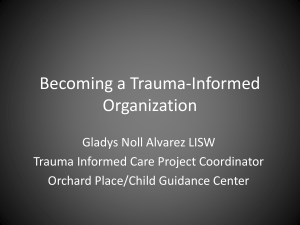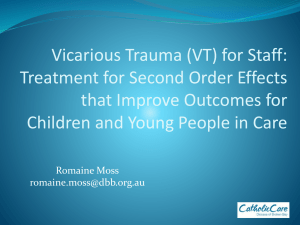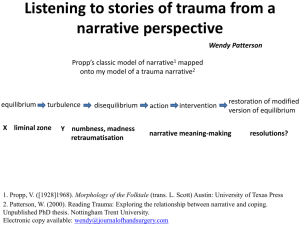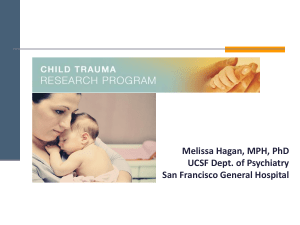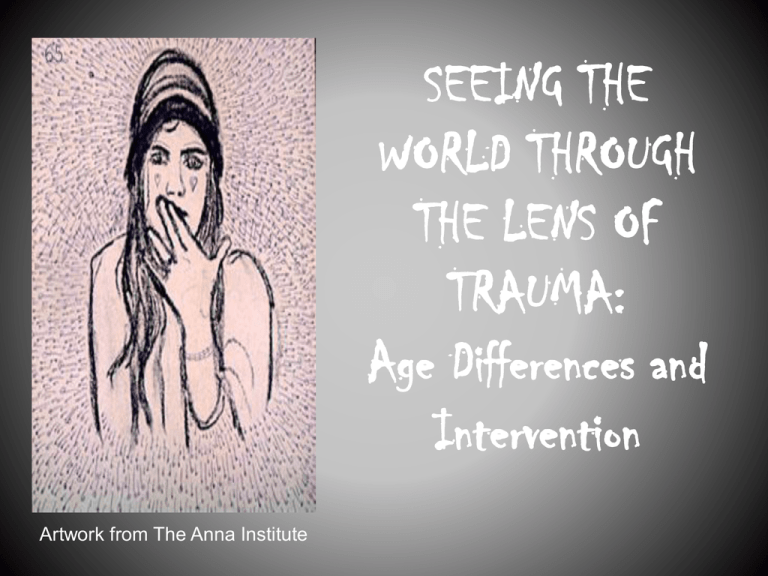
SEEING THE
WORLD THROUGH
THE LENS OF
TRAUMA:
Age Differences and
Intervention
Artwork from The Anna Institute
WHAT IS TRAUMA?
Traumatic Event
A person experiences, witnesses or is
confronted with actual or threatened
death or serious injury or threat to the
physical integrity of oneself or others
Often includes a response of intense fear,
helplessness or horror
Can result from private or public
experiences
APA – DSM-IV
Developing Definition of
Trauma
Event
Experience
Effects
◦ Actual or extreme threat of physical or
psychological harm or the withholding of material or
relational resources essential to healthy
development. It can be a single event or repeated
events
◦ How the person assigns labels or meaning to the
event, depends on the perception of the individual
◦ Result of the person’s experience of the event.
This can include neurological, physical, emotional or
cognitive effects
Working definition – SAMHSA, Trauma and Justice
What We Know
Trauma occurs when external events
overwhelm a person’s coping responses
Severe and/or chronic trauma can have
lasting adverse effects on physical,
psychological, and social well-being
Trauma is prevalent, at least 50% in
general population have at least one
traumatic event; more than 25% have
two or more. In the human service field
the majority of the population served
have a trauma history
What We Know
Trauma can result from adverse childhood
experiences, natural disasters, accidents,
interpersonal violence or war
Early, severe and/or chronic trauma can
affect the brain which can result in
behaviors and emotions that appear
maladaptive
Trauma has an extremely high correlation
with poor health and social outcomes
Why Do I Need to Understand
Trauma
•
Nearly one in three adolescents have been
physically or sexually assaulted by the age
of 16 (Boney-McCoy & Finkelhor, 1995)
•
Violent Crime victimization in youth is twice
as high as that for adults (Hashima and
Finkelhor, 1999)
•
Rates of PTSD among adults who were
formerly placed in foster care was found to
be twice as high as rates as in US War
veterans ( Northwest Foster Care Alumni
Study, Pecora, et al., 2005)
Chronic Trauma
Chronic trauma refers to the
experience of multiple traumatic events. These
multiple events may be varied, such as a person who is
exposed to domestic violence, involved in a serious car
accident, and then becomes a victim of community
violence.
Chronic trauma may refer to longstanding physical
abuse, neglect or war.
Chronic trauma represents cumulative effects. Each
new event reminds the individual of prior trauma and
reinforces its total negative impact. To the person it
feels relentless and uncontrollable
Transgenerational Trauma
Violent trauma is often self-perpetuating
Trauma affects the way people approach
potentially helpful relationships
Relationship with
caregivers plays a critical
role in regulating stress
hormone production
(study showed link between quality of
childcare linked to stress hormone levels)
Adverse Childhood Experience (ACE) Study
Without intervention, adverse childhood events (ACEs) may result in long-germ disease, disability, chronic social
problems and early death. Importantly, intergenerational transmission that perpetuates ACEs will continue without
implementation of interventions to interrupt the cycle.
Adverse Childhood
Experiences
•Abuse of Child
•Psychological abuse
•Physical abuse
•Sexual abuse
•Trauma in Child’s
Household Environment
•Substance Abuse
•Parental separation &/or
Divorce
•Mentally ill or suicidal
Household member
•Violence to mother
•Imprisoned household
member
•Neglect of Child
•Abandonment
•Child’s basic physical &/or
Emotional needs unmet
Impact of Trauma & Adoption
of Health Risk Behaviors
Neurobiologic Effects of Trauma
•Disrupted neuro-development
•Difficulty controlling anger
•Hallucinations
•Depression
•Panic reactions
•Anxiety
•Multiple (6+) somatic problems
•Impaired memory
•Flashbacks
Health Risk Behaviors
•Smoking &/or Drug abuse
•Severe obesity
•Physical inactivity
•Self Injury &/or Suicide attempts
•Alcoholism
•50+ sex partners
•Sexually transmitted disease
•Repetition of original trauma
•Eating Disorders
•Dissociation
•Perpetrate domestic violence
Long-Term Consequences
Of Unaddressed Trauma
Disease & Disability
•Ischemic heart disease
•Cancer
•Chronic lung disease
•Chronic emphysema
•Asthma
•Liver disease
•Skeletal fractures
•Poor self rated health
•HIV/AIDS
Social Problems
•Homelessness
•Prostitution
•Delinquency, violence & criminal
Behavior
•Inability to sustain employment•Re-victimization: rape; domestic
Violence
•Inability to parent
•Inter-generational transmission
Of abuse
•Long-term use of health & social
services
Adapted from presentation Jennings (2006). The Story of a Child’s Path to Mental Illness.
Three Major Findings
1. Experiences are vastly more common
than recognized or acknowledged,
2. The ACE Study reveals a powerful
relationship between our emotional
experiences as children and our
physical and mental health as adults,
as well as the major causes of adult
mortality in the United States, and
3. Documents the conversion of
traumatic emotional experiences in
childhood into organic disease later
in life.
Brain Development
Brain at Birth
25% the size of the adult brain in
weight and volume (less than 1lb)
Nearly the same number of neurons as
adult brain (100 billion)
50 trillion synapses (connections
between
neurons)
Brain stem and lower brain well
developed (reflexes), higher regions
more primitive
Developmental Implications
More stimulation, the better for
neural development
Genetics form the basis (nature), but
environment and experience (nurture)
drive the developmental processes
Adverse inputs (abuse, chemical
exposure, malnutrition) likely to have
lasting effects
General Principles Regarding the Effects of
Early Experience on Development
Brain Architecture and Skills are Built in a
Hierarchical “Bottom-Up” Sequence
Neural circuits that process basic information
are wired earlier than those that process more
complex information.
Higher circuits build on lower circuits, skills
beget skills, and the development of higher level
capabilities is more difficult if lower level
circuits are not wired properly.
Social, Emotional, and Cognitive Development are
Highly Interrelated
Brain Plasticity and the Ability to Change
Behavior Decrease Over Time
Impact of Trauma
Strong and prolonged activation of the
body’s stress management systems in
the absence of the buffering
protection of adult support, disrupts
brain architecture and leads to stress
management systems that respond at
relatively lower thresholds, thereby
increasing the risk of stressrelated physical and mental illness
Body Chemistry
• Recognition of threat stimulates stressresponse pathways. Adrenaline and
several endocrine hormones are released
into the bloodstream.
• Repeated acute stress response takes a
toll on the body over time
• The individual may not fully return to
baseline so may function at a hyer or
hypo state of arousal
Developmental Response To Trauma
The meaning of a traumatic event
is based on the individual’s stage
of neurological, cognitive and
emotional development.
Identifying Children
Be aware of both the children who act out
AND the quiet children who don’t appear to
have behavioral problems.
Internalizing
These students often “fly beneath the radar” and do
not get help. They may have symptoms of avoidance
and depression that are just as serious as those of
the acting out student.
Impact on Relationships
Relationships are developed through the
emotional bond between the child & primary
caregiver. It is through this relationship we
learn to:
◦ Regulate emotions/“self soothe”
◦ Develop trust in others
◦ Freely explore our environment
◦ Understand ourselves & others
◦ Understand that we can impact the world around
us
Young Children
Lacking an accurate understanding of the
relationship between cause and effect,
young children believe that their thoughts,
wishes, and fears have the power to become
real and can make things happen.
Young children are less able to anticipate
danger or to know how to keep themselves
safe, and so are particularly vulnerable to
the effects of exposure to trauma.
Children may blame themselves or their
parents for not preventing a frightening
event or for not being able to change its
outcome.
Young Children
Young children cannot express in words
whether they feel afraid, overwhelmed, or
helpless.
Traumatic events have a profound sensory
impact on young children.
Young children who experience trauma are
at particular risk because their rapidly
developing brains are very vulnerable.
Young children depend exclusively on
parents/caregivers for survival and
protection―both physical and emotional
Young Children
Separation anxiety or clinginess towards
teachers or primary caregivers
Regression in previously mastered stages of
development (e.g., baby talk or
bedwetting/toileting accidents)
Lack of developmental progress (e.g., not
progressing at same level as peers)
Re-creating the traumatic event (e.g.,
repeatedly talking about, “playing” out, or
drawing the event)
Young Children
Difficulty at naptime or bedtime (e.g.,
avoiding sleep, waking up, or nightmares)
Increased somatic complaints (e.g.,
headaches, stomachaches, overreacting to
minor bumps and bruises)
Changes in behavior (e.g., appetite,
unexplained absences, angry outbursts,
decreased attention, withdrawal)
Over- or under-reacting to physical contact,
bright lighting, sudden movements, or loud
sounds.
Assess
Reactions of the child and caregivers
Changes in the child’s behavior
Resources in the environment to
stabilize the child and family
Quality of the child’s primary
attachment relationships
Ability of caregivers to facilitate the
child’s healthy socio-emotional,
psychological, and cognitive
development
Support for Young Children
Helping children and caregivers reestablish
a safe environment and a sense of safety
Helping parents and children return to
normal routines
An opportunity to talk about and make sense
of the traumatic experience in a safe,
accepting environment
Explaining the trauma and answering
questions in an honest but simple and ageappropriate manner
Child Trauma Toolkit for Educators, NCTSN
Support for Young Children
Teaching techniques for dealing with
overwhelming emotional reactions
Helping the child verbalize feelings rather
than engage in inappropriate behavior
Involving primary caregivers in the healing
process
Connecting caregivers to resources to
address their needs–young children’s level
of distress often mirrors their caregiver’s
level of distress
Child Trauma Toolkit for Educators, NCTSN
Interventions
Child Parent Psychotherapy (0-6 y/o)
Parent Child Interaction Therapy (<12 y/o)
Trauma Focused Cognitive Behavior
Therapy (3 to 21 y/o)
Combined Parent Child CBT (4 -17 y/o)
Eye Movement Desensitization and
Reprocessing
Elementary Age Children
Anxiety, fear, and worry about safety of
self and others (more clingy with teacher or
parent)
Worry about recurrence of violence
Increased distress (unusually whiny,
irritable, moody)
Changes in behavior:
◦
◦
◦
◦
Increase in activity level
Decreased attention and/or concentration
Withdrawal from others or activities
Angry outbursts and/or aggression
Child Trauma Toolkit for Educators, NCTSN
Elementary Age Children
Absenteeism
Distrust of others,
affecting how children interact with both
adults and peers
A change in ability to interpret and respond
appropriately to social cues
Increased somatic complaints (e.g.,
headaches, stomachaches, overreaction to
minor bumps and bruises)
Changes in school performance
Child Trauma Toolkit for Educators, NCTSN
Elementary Age Children
Recreating the event (e.g., repeatedly
talking about, “playing” out, or drawing the
event)
Over- or under-reacting to bells, physical
contact, doors slamming, sirens, lighting,
sudden movements
Statements and questions about death and
dying
Child Trauma Toolkit for Educators, NCTSN
Elementary Age Children
Difficulty with authority, redirection, or
criticism
Re-experiencing the trauma (e.g.,
nightmares or disturbing memories during
the day)
Hyperarousal (e.g., sleep disturbance,
tendency to be easily startled)
Avoidance behaviors (e.g., resisting going
to places that remind them of the event)
Emotional numbing (e.g., seeming to have no
feeling about the event)
Child Trauma Toolkit for Educators, NCTSN
Interventions
Cognitive Behavioral Interventions
for Trauma in Schools (6 -15 y/o)
Functional Family Therapy (6-21
y/o)
Adolescence
Increased risk for substance abuse
Concern over being labeled “abnormal” or
different from their peers may cause
adolescents to withdraw from family and
friends.
Adolescents often experience feelings of
shame and guilt about the traumatic event
and may express fantasies about revenge
and retribution.
Discomfort with feelings (such as troubling
thoughts of revenge)
Interventions
Seeking Safety for Adolescents
Structured Psychotherapy for
Adolescents
Responding to Chronic
Stress(SPARCS) (12-19 y/o)
Resources
National Children’s Traumatic Stress Network
www.nctsnet.org/nccts
National Center on PTSD www.ncptsd.va.gov/facts/specifics
Helping Traumatized Children Learn
http://www.massadvocates.org/documents/HTCL_9-09.pdf
The Heart of Learning and Teaching
http://www.k12.wa.us/CompassionateSchools/pubdocs/TheHeartofLea
rningandTeaching.pdf
www.annainstitute.org
www.aacap.org/clinical/ptsdsum.htm (American
Academy of Child & Adolescent Psychiatry)
www.nimh.nih.gov/healthinformation/ptsdmenu.
cfm (National Institute of Mental Health)





